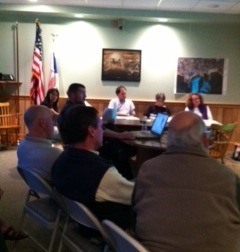The evening’s meeting started out quickly with a fast turnaround for Brian Porter, Vice President of Brophy & Phillips Co. Real Estate regarding Mattapoisett Landing Units 6, 7, 8, and 102 situated on Fairhaven Road. Porter was before the board to explain plan changes for one unit from triplex to a duplex. With no concerns, the board approved the changes as submitted.
The balance of the night was then given over to Grant King, Principal Comprehensive Planner for SRPEDD for a public hearing on the draft of Mattapoisett’s future in terms of re-zoning, land protection, property protection, and growth.
King prefaced his presentation by stating for the assembled, “This is not SRPEDD’s work; this is your work.” He also made it clear that is was an informal conversation of the draft work that had been done with a coalition of townspeople from Mattapoisett. He then explained the necessity of this work for Mattapoisett’s future.
Putting the material in context, he said that in 2008, as part of the Southcoast Rail Project, an original plan was prepared. Via a PowerPoint presentation, he overlaid the 2012 plan to demonstrate some differences for the group’s consideration.
He then explained that a 2010 state executive order (EO 525) required cities and towns in the corridor region to establish fully fleshed out plans. The directive doesn’t tell municipalities what they must do or develop, plan or build, but that those plans have merit. Throughout his presentation, King emphasized that the draft was the town’s plan, not SRPEDD’s.
He explained the priority development areas were where the group thought types of light commercial or other construction might be reasonable to help revenue sources for the town. One example is a site off Crystal Springs Road that is an old gravel pit; it might be considered for rezoning for low impact development
The meeting was then turned over for public comment.
Bonnie DeSouza said the “landfill area was recently approved for solar farm – it’s a perfectly good area for that.” She added that “another old gravel pit behind the Knights of Columbus might be a good spot for commercial development” and “the entire length of Route 6 should be more business friendly.” She went on to say “We don’t want to change laws that might affect the use of the boatyard areas, for the important work it does for our water recreation.”
Mary Crain asked, “Can the same be said about the boat yard at Brandt Island?”
King said the same logic would apply and swiftly made the changes to the draft.
Paul Osenkowski asked, “What is low impact development?”
King said it is “mostly associated with storm water runoff … so rather than a CVS coming in, rather than just building a parking lot, we could make them build in swales to divert rain water runoff.”
Osenkowski said, “It seems because of an executive order we are being asked to increase the number of homes and businesses so that we can increase revenue into the town and pack more people into cluster development.”
Again King said, “This is not SRPEDD’s work, this is not the state’s work, this is your fellow citizen’s work.” He said, “this is a basic plan use exercise which is taking place across the 27 communities in SRPEDD coverage.” He continued, “where do the towns want growth, where to the towns want protection … the state is providing grants for towns that have made statements about growth … there is some incentive [to the town] by making money available.”
The state is offering two types of grants. One is for Massworks projects such as sewer extensions, bike paths, roadwork, and the other is for economic development studies that may include residential expansion studies. But King also said, “The state is not trying to influence behavior with funding.”
Brad Hathaway spoke, saying, “25 years ago they tried to extend the business along route 6, the same town meeting they turned the same business area back to residential. … I think this is a very poor turnout by the town on something that is so important to the town,” noting that there were approximately 15 people present.
Hathaway then reminded the group, “We can not protect the wetlands in this town without a wetlands protection bylaws, mostly because of the action of the Conservation Commission. Until we get wetlands protection bylaws, this is ridiculous.”
King responded, “But we are not talking about zoning now … that would have to go to town meeting for public vote before any of these suggestions, before any zoning changes can be implemented.”
Gary Johnson asked, “Can you compare Mattapoisett to Marion,” indicating that he wished to see how the latter had zoned its part of Route 6. He said, “We can’t have non-discriminatory plans for Route 6 from border to border.”
Bob Rogers wanted to clarify that, “business development doesn’t mean it has to be commercial development … it could be medical offices, or senior housing.”
Board member Karen Fields asked King, “What do you see in the future for villages to stay a village?” King replied, “Good planning and good zoning work.”
King went on to say that SRPEDD will review the plans to find the things that are most important for the town. He encouraged everyone to participate in regional meetings and to visit the SRPEDD website at www.srpedd.org/scr-update.asp.
By Marilou Newell
